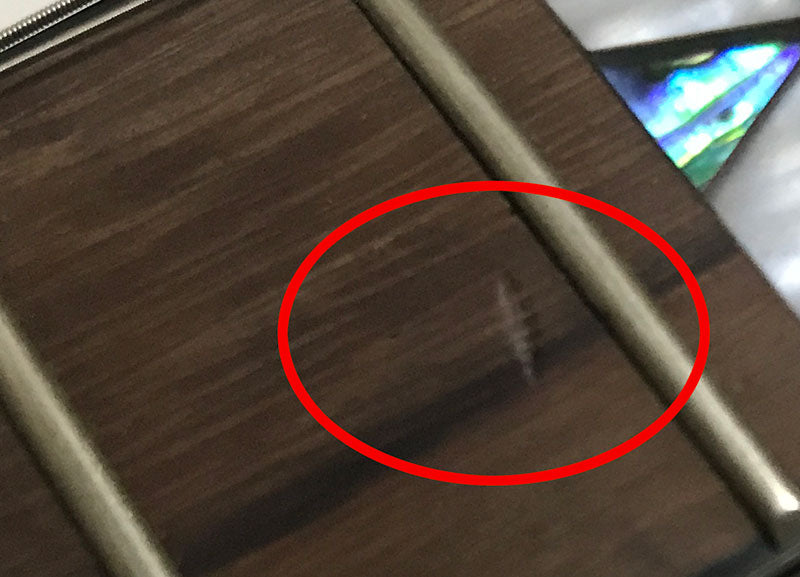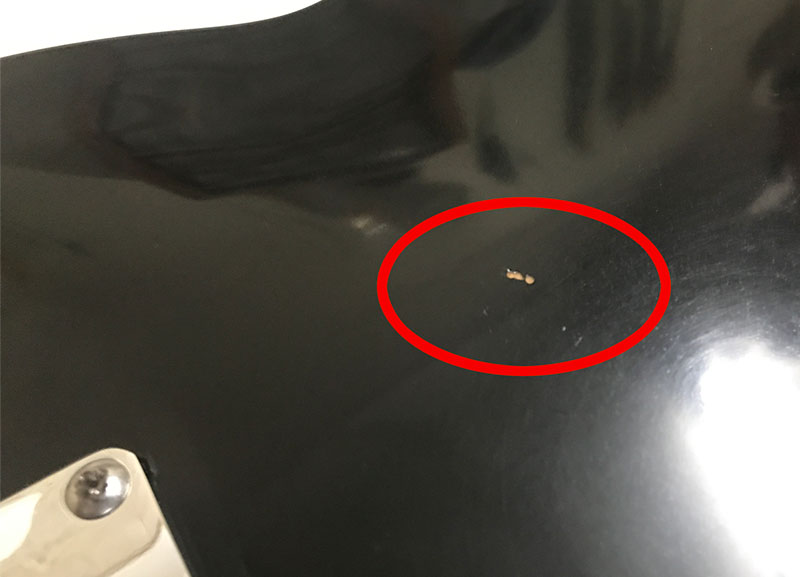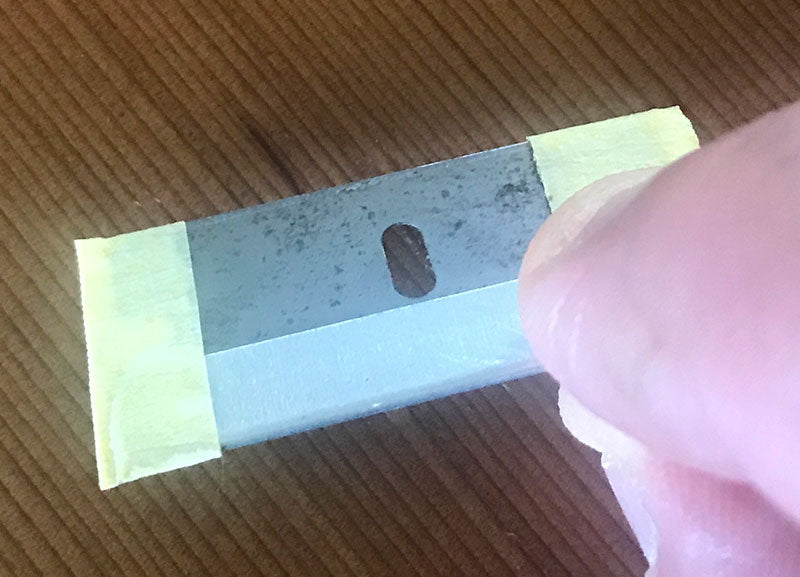How To Repair Guitar Finish
Information technology tin be a real source of frustration to find a dent or fleck on your guitar kit's body or cervix. And, while information technology may seem impossible to fix all is definitely non lost. In the following article, we're going to accept a look at some methods you lot can use to repair dents on your guitar kit along with some additional options for repairing fries in unfinished and finished guitars.
Dents and chips, what's the difference?
Before we can begin the repair process we beginning demand to identify the problem as nosotros will use unlike methods for dealing with dents every bit opposed to chips.
Dents
The image below shows a dent on this otherwise cute rosewood fretboard.

Dents for those unaware are indentations in the timber of the guitar. The wood grains are not broken which means the timber has been compressed rather than a section removed.
Chips

A chip occurs when a section has been completely removed. You can identify chips in unfinished timber every bit the grains of the timber will be broken and expect torn.
Too read:Sanding a Guitar Body Prior to Painting
In finished guitars, a chip is easier to identify and will usually but have affected the finish leaving the timber beneath unaffected, every bit per the paradigm above.
This is one of the chief purposes of a guitar's finish, to protect the timber of the guitar along with beingness pleasing to the eye.
What causes chips and what causes dents?
Dents and fries are typically the results of force due east.g. an impact on the guitar e.k. something is dropped on the guitar's torso or neck or the guitar itself has been dropped onto something hard due east.thou. an edge of a workbench.
The amount of forcefulness or hardness of the object the guitar has come into contact with usually determines if the guitar has a dent or has been chipped.
Dents are usually much easier to fix and are more than common than dents in unfinished timber, while chips are more than probable to occur later on the guitar has been finished.
Repairing Dents in Guitar Kits
As dents are caused by compression, ultimately nosotros need to decompress the dented area to render the guitar to its previous state.

This is best washed using a combination of wet and heat which can be applied using a clean rag and soldering iron.
This method is effective on unsealed timber e.g. unfinished guitar body or a fretboard. However, a sealed guitar torso is less likely to suffer a dent in the first place due to the protection the seal coat offers. If you are working with a guitar that has a sealer coat applied lightly sand the sealer coat away in that specific expanse and apply again once completed.
Materials
- Soldering iron
- Make clean Rag
- Moisture
Method
- Switch on your soldering iron and allow information technology to heat upwards
- Dampen a clean rag. It shouldn't be dripping wet simply should be clammy.
- Fold the rag over itself 2-three times to ensure the direct heat from the soldering iron will non be in contact with the timber and cover the dent with the clammy rag.
- Apply heat to the affected surface area until the rag is by and large dry. Don't agree the soldering atomic number 26 in one place for too long. Retrieve more virtually applying heat to the area rather than pressing hard against the paring itself.
- Bank check your piece of work, and reapply if necessary.

Equally seen in the image above the dent has now been completely removed. This merely took around 1 minute of applying estrus to the damp rag. Deeper dents will take longer.
In some instances dents can be much deeper than the example above. If this is the example effort the method above first but if unsuccessful consider filling the dent using a tinted filler.
Repairing Fries in Guitar Kits
As previously mentioned the majority of chips found on guitars occur after the terminate is applied. In this example, nosotros are actually repairing the finishing coats rather than the timber which requires a drop make full.
Depending on how your guitar is finished this will determine the arroyo we take. For instance, if the chip is but affecting the clear gloss coats (if yous have used a articulate coat to finish the guitar) nosotros can utilize superglue which bonds nicely with most finishes. Followed by scraping and sanding flat.
Besides read: Forest Grain Filler for Guitar Bodies
If all the same the color coat has also been affected we need to fill the chip with the matching colour used to stop the guitar, before proceeding on to repairing the seal coat.
This might represent a problem if repairing a standard electric guitar as the end will be difficult to match. But fortunately, every bit we are repairing a guitar kit there's a good gamble you accept some finishing supplies leftover or can source more than of the aforementioned color you previously used.
If on the other hand, the dent has occurred to an unfinished guitar body try to source a filler that is a close match to the unfinished timber, there are diverse tinted fillers available. When finishing the guitar e.chiliad. staining or painting any modify in appearance as a result of a less than perfect match will be less obvious or unable to be seen if finishing in a solid color.
Materials
- Razorblade and masking record
- Finishing production e.k. either the matching color used on the guitar if repairing a color glaze. Superglue if repairing a clear coat or tinted filler if repairing an unfinished torso.
- Medium to light grades of sandpaper.
- A syringe or something similar to employ small amounts of finishing material to a minor department.
- Polishing rags.
Method

- Burr the edge of a razor blade by running it confronting a metallic object. The small burr created will be used to drag back over the fill up and aid create a smoothen finish. *This is a tip from master guitar repairer Dan Erlewine.
- Wrap the outside edges of the razor blade with masking record to allow the blade to sit down slightly higher than the surface of the guitar, equally per the image above. This allows the cease to be scraped flat while preventing the bract catching on the body and scratching the surface.
- Clean the area the dent has occurred with a make clean rag and if necessary use a pocket-sized sharp blade to remove any loose materials on the outside edges of the chip. The chipped area should be completely free of any loose debris.
- Make full the chip with the matching colour using either a syringe or a similar item.
- If repairing a clear coat employ a small-scale amount of super glue to seal the chip directly over the previous layer. The finish should sit slightly above the surface of the guitar torso.
- Allow to dry.
- Drag the razor blade over the raised area. You won't need to use a lot of force, the blade volition be sufficiently abrupt enough to begin removing much of the excess.
- Lastly, sand down the affected area working your manner through the diverse grades of sandpaper until no visible scratch marks are remaining and finish by polishing the affected surface area.
Summary
Knowing how to ready dents and chips on guitar bodies is a valuable skill particularly if yous program on edifice more than 1 guitar.
Likewise read: Sanding a Guitar Body Prior to Painting
Equally can be seen in a higher place the methods used are straightforward and don't require specialist tools or experience. And then, side by side time yous spot a paring or chip on your new DIY guitar kit remember all is not lost and in most cases, it's more than possible you lot can take the guitar looking every bit good as new without too much trouble.
How To Repair Guitar Finish,
Source: https://guitarkitworld.com/blogs/resources/fix-dents-cracks-guitar-kits
Posted by: harbinforrounce.blogspot.com


0 Response to "How To Repair Guitar Finish"
Post a Comment